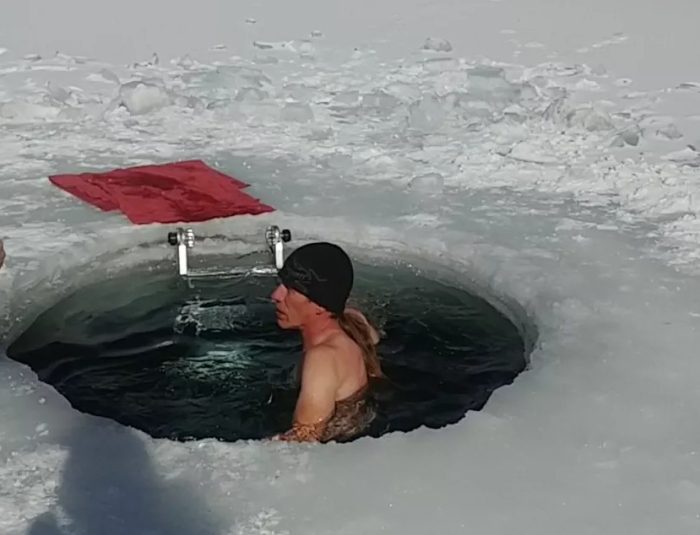The fact that we can think about our thoughts, observe how we are acting, and notice how we are feeling, means that we can change or adjust them if we choose to.
In psychology, this is known as metacognition. We like to say that we know ourselves, but what if we really only know the thoughts and feelings that we are familiar with?
Last winter I did the cold water immersion, sometimes referred to as a polar plunge or ice bath. It is the process of allowing one’s body to spend time in water that is below 58 degrees Fahrenheit. In this case, it was considerably closer to the freezing temperature. I have read about the health benefits of doing this, such as improved circulation and reduced muscle inflammation, among other things. Some of the proclaimed benefits are proven, and some are just theorized. I was definitely intrigued by these benefits, but there was another reason—the main reason that made me want to do this.
Have you ever gotten on a plane or had to speak in public and your heart starts racing, you get a particular unrest in your stomach, and palms start sweating? Have you ever been in traffic and started getting anxious and your muscles tensed because you thought you were going to be late to wherever you were going? Our body is producing a physiological response—an actual physical reaction—to a thought. What’s more, these thoughts are of a perceived or hypothetical or imagined outcome. While these may be on the extreme end of examples, they illustrate the fact that our thoughts create chemistry in our body. This is biology.
When you begin to get into water that is this cold, the process begins with an involuntary gasping, almost hyperventilation. The heart starts racing and panic sets in. Adrenaline, glucose, fats, cortisol, and beta-endorphin hormones are dumped into the bloodstream—a chemical storm that creates the classic fight-or-flight sensation. Does it sound like fun, yet? This is what happens physiologically as our body reacts to a combination of external stimuli and our thoughts. But, wait, there’s more!
While standing on a towel on the ice in nothing but a swimsuit, looking into the hole that’s been cut into the ice to access the river and watching the frigid water flowing underneath the ice, the mind is initially consumed by panic, discomfort, apprehension, and even fear. There is a choice at this time to let these thoughts and feelings take control and influence the decision, or to go on—in spite of them.
To continue is to descend the ladder into the water. Once into the water above the knees, the involuntary gasping begins. There is an awareness of the gasping. To be aware of something occurring internally means that it can also be altered or changed. Again, a choice is made. Focus. Slow, intentional breaths. Focus is only on the breathing. All the way in the water now while still taking slow and intentional breaths.
Something shifts. The nervous system has been tapped into. The reaction is now being controlled. The voices that are around become incoherent, almost white noise or even completely blending in with the surrounding environment. Focus is on one single voice—the voice saying to breathe. Eventually, that voice fades out as a kind of hyperawareness to the moment sets in.
Every sensation is felt and noticed. It is observed, peculiarly enough, how being entirely and thoroughly in the moment and aware of every mental and physical sensation seems like an out-of-body experience. After 30 seconds, a voice pierces the experience of the moment saying, “Time’s up!” and it’s over. Climbing the ladder to get out of the water brings awareness to not being able to feel the steps with the feet, even as they’re being stood on, and the cold winter air is not as cold as it was before getting into the water.
We tend to stop ourselves from doing something when we reach a particular point that we have determined to be uncomfortable. This stopping point is well below the limit that we are actually capable of reaching; it’s only a level of personal comfort. We want what’s easy. We crave comfort and the familiar. But if we are doing everything that we can to remain in this place of comfort, we can never genuinely know our true potential. Our body will only go where we let our mind take it, and this is the part that had me so intrigued.
Most people fail to see the value of discomfort, but to discover what we are capable of and to really know ourselves, we must take ourselves to places we are not familiar with—to uncomfortable places—and to challenge ourselves and to push ourselves to uncomfortable levels. We can say that we know ourselves all day long, but if we never allow ourselves to be in uncomfortable situations, how can we possibly know? It is in discomfort, in the uncomfortable situations, that we can learn the most about ourselves, but it requires getting beyond the fears and the doubts and actually facing ourselves.
A cold water immersion can reveal how much—or how little—control we have over our own inner workings. We have much more control over our internal world than many of us know or care to believe. We may not be able to control what is happening, but we can absolutely control how we respond to what is happening.
The only environment that we have control over is our internal one, yet that’s the environment that we least try to control because we’re busy trying to “fix” everything or everyone else. We need to control the only thing that we were ever really able to control to begin with: ourselves. But, then again, how do we control something that we don’t really understand?
~









Read 6 comments and reply